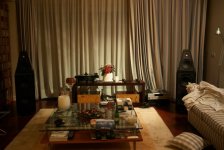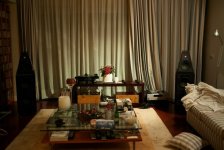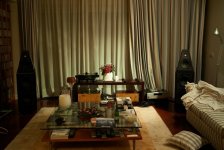Interesting indeed. To me it was night and day but i tried the CV once only. Would you have some pics taken with the Leica and the CV at f/2 in the same conditions? Also at f/4 to show the focus shift or lack thereof?
Sorry, all my posts tend to get long these days
🙁 And this one is no exception
🙁 I have to quit doing this... But since I wrote it, I think I'll hit the button... Please feel free to ignore everything below the first paragraph...
🙂
Yes, I'll do that ASAP. I have a couple of photos that I used for a quick test, and last night I went and took a few more. I will try to shoot something to see about the focus shift (that hasn't been a problem in "real life", until now, unlike the 35/1.4 Nokton, that came and went in 2 days). I will give my best to do it on the weekend (btw, one of the tasks in my agenda reads "compare all my 28mm lenses and post results on RFF" and has been there for a few months... Really!
🙂) FWIW, I will try to add to the mix a few shots from my Nikon D700 and my old 35/2 AF Nikkor, just to get some perspective on "image quality".
-------- Ignore from now on, unless you have some spare time -----
We have to bear in mind a couple of things:
1) probably the Ultron has a more curved field than the Summicron, so when we photograph flat subjects (ex: a test chart), the Summicron will look sharper in the corners. But in real life, that hasn't been a problem at all. DOF at f2, even with a 28, is thin enough, camera-shake will creep in, subjects will move, etc, so the small loss of sharpness in the corners hasn't been bothering a lot (make that none at all, to be fair). ex: even on a test shot of a shelf with books (more or less flat) one of the corners will be better on the Cron, on another it will be almost the same.
2) the Ultron has more fall-off wide-open than the Summicron but I would say that's to be expected from a fast RF 28 that is so small and inexpensive. The Summicron is better? Yes. Will I keep mine? Most probably. Is it perfect? No. But it's not a big problem. Again: in real life (unless when we have a lot of sky in the picture) I seldom find perfectly lit flat walls. I tend to use f2 when there is low light and no tripod. That means "by night and artificial lighting" and lighting is always going to be point sources. So, even with a perfect lens in terms of fall-off, I would get darker zones that look like fall-off from the lens. (btw, even a "fair" test for fall-off will require a careful setup, the kind Sean Reid does).
3) although (good) lens behave more or less the same way on perfectely focused zones, they seldom do the same on OOF and on the transition. Both my f2 and f1.9 Ultron have a way of rendering OOF zones in the corners that can be bothering, with images getting almost a "camera-shake" movement that's surprising (I have been complaining about this effect on my f1.9 Ultron since I subscribed to RFF and you may remember that...
🙂). This character can also produce a kind of "vaseline" effect in those areas and in extreme cases (some focusing distances) it can even produce a faint double image. I can't say if this is a design or fabrication problem (decentering, because some corners tend to be more probelmatic than others), but it's something I never saw on a Leica lens. My f2 is much better than my f1.9 in this regard and it only shows once in a while.
4) looking at 100% on a 19in monitor, from 50cm, is a different business than looking at a "normal" (30cm x 40cm max) print from a "poster" distance. Most of the differences in resolution and sharpness that show up
at 100%, will be very much "squashed" by the low-frequency sharpening that a good digital print needs.
The other stuff (colour rendition, contrast - be it local or global, vignetting, etc) is usually dealt with on my normal workflow - DNG, CornerFix, CaptureOne Pro - plus a bit of tweaking on Photoshop on photos that deserve it (and 95% don't deserve).
So, while I can get photos I don't like from my Ultron f1.9 at f2, I have yet to find a "real life" photo from the Ultron f2 that I wouldn't want to print (from a technical POV).
I'll try to find the time to do a few crops (and I need to crop so that differences can readily be seen, something that tells me the lenses are comparable - you don't need a crop to tell the difference between my Jupiter 9 and my 75 heliar, both at 2.5...) and post them.
Again, please note that I'm not "defending" the CV f2, or "attacking" the 28 Cron (I keep both!
🙂). It's just that my sample of the CV f2 is good enough for me to ponder selling the Cron (albeit with some "heart shrinking"...) and I would never say that about my f1.9 CV (probably, THE bad sample).
As a matter of comparison, I had a 50/2 Summicron (the new version) and a 35/2 Summicron ASPH and I sold them. Between the very, very good (I would say, surprisingly good) 50/1.5 Nokton and the collapsible Summicron I have, the 50 was redundant, unless I was pixel-peeing and doing test charts (or shelves) everyday (I don't). Ditto on the 35/1.2 Nokton + 35 UC-Hexanon and the 35/2 Cron ASPH that went out the door. And yet, I still keep the 28 Cron...
🙂
I would definitely say that the CV f2 Ultron (at least a good copy), easily qualifies as a "poor man's" 28 cron asph. I can't say that about my copy of the 28/1.9 Ultron and I said even more than that about the 50/1.5 Nokton (I sold the cron). On the other hand, a lot of people (sean reid included) find it the other way round and prefer the old version. Since the "disagreement" is so strong, I would say that probably we have a case of both different taste AND different samples...
🙂 BTW, I haven't sold the CV 28/1.9 either, I use it for B&W on the CLE and the M3 and really like it.
So... Like in audio, nothing like using the lens for a while and trust both our eyes AND the manufacturer claims: if it's much worse than we thought, maybe we got a bad sample. Let's return it and get a new one. The manufacturer thanks, because the alternative is getting "stamped" by a few bad reviews, that could easily be triggered by bad samples. When I bought the 35/1.4, I had high hopes for the lens (and I was planning to sell the 40/1.4, mainly because of framing). The sample I got was misfocusing by inches and had a lot of focus shift. And I sent it back. The reason why I didn't ask for a replacement, is because I found out I would not gain a lot by getting the 35/1.4 instead of the 40/1.4 (on my CLE, the 40 is even better for framing), so I skipped the hassle of selling the 40/1.4 AND dealing with the replacement and (who knows?) another defective lens on the mailbox. But I am fully convinced that the "CV 35/1.4" (that is, the lens designed by Cosina...) is better than the lens I got and further production runs will take care of the inconsistencies that can and will creep in when assembling something like a 35/1.4 lens that smal, light and inexpensive.
Leica has a way of engineering lenses that enables them to produce, in a very consistent way, lenses that come up to spec and are still light and small, not to mention that absolute image quality is outstanding. They sometimes opt for a "worse" theoretical optical formula but that allows the lenses to be produced within the tolerances of THEIR fabrication process (of which they know very well the limitations), including glass production.
Moreover, they do heavy QC (we have a factory in Portugal - I guess the only one out of Germany - that I visited three times and I have to say I was impressed. REALLY impressed.) and adjust each lens individually. On the same vein, you should check the thread on Leica Users on the Anatomy of a Leica M8 (
http://www.l-camera-forum.com/leica-forum/leica-m8-forum/21331-anatomy-leica-m8.html - crazy thread!!!): sensors are individually shimmed, for perfect alignment, with shims that can be 0.01mm thick, and get different shims for each corner. That's QC and attention to detail...).
All this R&D and all this QC cost money. I don't think leica lenses are as cost-effective as a CV, especially if you are lucky and/or have the patience to go through the process of buy/send back until you get a "perfect" sample. But you can be pretty sure that the Cron you will receive in your house will be much more like Steve's copy and (even better!) more like the "ideal" 28 Cron designed by Leica engineers, than two copies of "new" (as in "production bugs not yet ironed-out") CV lenses.
If you have the money, Leica lenses will be more "reliable" (in this sense) than CV lenses (at least in my experience and - as I read it - also from the experiences of lots other people). And they will _probably_ be "better" in absolute terms than the CV counterpart (but don't count on it as a "faith" issue).
That said, my respect for CV has been growing in the past few years (in fact, since I bought the Epson). I use Leicas since... I don't know, since I remember... A M3 DS, with the 35/3.5 Summaron, the 50/2 Summicron coll and the 90/4 Elmar is in the family since the 50s - all of them still going strong - and everybody switched to SLRs in the 70s, so lucky me...
🙂. And my idea of CV lenses was "they are cheap but good value".
I really changed my opinion: CV makes very good lenses and, as a bonus, they are very inexpensive when compared to Leica. Some of their lenses are better (the 75/2.5 and the 50/1.5 come to mind), some are worse (the 50/2.5 Skopar, while very sharp stopped-down, doesn't really cut it at even f4). Some of their samples are good (I was definitely lucky with my 50/1.5 - I've seen crops from other people that I, fortunately, can't reproduce), some are worse (my 28/1.9 Ultron is not on the same breed as the ones Sean uses, that's for sure).
But I find it very interesting that I need to do 100% crops to really see a difference (aside from things that are trivially corrected in digital) between two lenses almost 7x appart in terms of price (let's remember that RW sells the Ultron for 360£, while the Cron goes for almost 2000£, before taxes). And that's wide-open. At, say, f8, I guess my "testing" technique is more of a culprit for differences than the lenses...
🙂 Please take into account that this would be the same as getting a car that is so close to a, say, Mercedes E-class, that you would have to take it to a special track and do very special tests on the systems to find a difference. And yet, that hypothetical car would cost 7x less than the E-class (in Portugal, that would be 10k€ vs 70k€). I think that everybody would buy that car and Mercedes would almost be out of business...
🙂
To finish, another of my "pet peeves": digital is a different animal than film. A sensor is not a film. It's totally flat, so "real" field curvature will show up in *****s (film can curve and hide/exacerbate field curvature. Usually, hide.). It's razor thin, so either images forms EXACTLY on the surface or it will be blurred (film has thickness, so images can form some microns below the surface and either the enlarger or scanner lenses will be able to correct with some DOF). Sensors are much more reflective than film (and flat, remember?) so reflections from the sensor will stress the coating/shape of the rear element. Some sensors do have low-pass, IR filters. This means there will be some refraction that will depend on the angle and create weird patterns in the corners, espcially with the typical RF lenses. Sensors collect light in a "vertical parallel" way and RF lenses are designed to be small and light (not to be tele-centric). Etc.
I am positively sure that, if Leica or Cosina really wanted to create a line of lenses tottaly commited to digital, they could forget things like "ultimate resolution" (a sensor is very much limited in terms of resultion, at least the sensores we get on the M8 ad the Epson) and focus on things like "very good coating on the rear element". Or trade a bit of fall-off (easily corrected by software) for, say, more flatness of field. Or lack of distortion ofr coverage (small sensor). Etc.
But the question is, Leica and CV can't live on money just from digital RFs, so, they have to compromise. I would expect Leica and CV to slowly incorporate these new challenges (and degrees off freedom) into their R&D in the next years.
So, again, I find it remarkable that lenses designed with so much constraints perform so well in digital. Getting a (very) substantial part of that performance for 7x less money is an Engineering feat that I have to admire (I'm an engineer...
🙂. So, maybe that's the profound reason why I am "defending" the CV f2 after all, and why I am reluctant to sell it...
🙂
Yikes, this got long!!!!!
🙁



